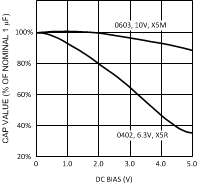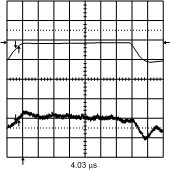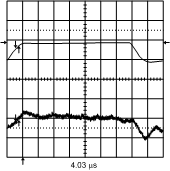SNVS468L September 2006 – November 2015 LP3972
PRODUCTION DATA.
- 1 Features
- 2 Applications
- 3 Description
- 4 Revision History
- 5 Device Comparison Tables
- 6 Pin Configuration and Functions
-
7 Specifications
- 7.1 Absolute Maximum Ratings
- 7.2 ESD Ratings
- 7.3 Recommended Operating Conditions
- 7.4 Thermal Information
- 7.5 Electrical Characteristics
- 7.6 Electrical Characteristics: LDO RTC
- 7.7 Electrical Characteristics: LDOs 1 to 5
- 7.8 Electrical Characteristics: Buck Converters SW1, SW2, SW3
- 7.9 Electrical Characteristics: Backup Charger
- 7.10 Electrical Characteristics: I2C Compatible Serial Interface (SDA and SCL)
- 7.11 Logic Inputs and Outputs DC Operating Conditions
- 7.12 I2C Compatible Serial Interface Timing Requirements (SDA and SCL)
- 7.13 Power-On Timing Delays
- 7.14 Typical Characteristics
-
8 Detailed Description
- 8.1 Overview
- 8.2 Functional Block Diagram
- 8.3 Feature Description
- 8.4 Device Functional Modes
- 8.5
Programming
- 8.5.1
LP3972 Reset Sequence
- 8.5.1.1
LP3972 Controls
- 8.5.1.1.1 Digital Interface Control Signals
- 8.5.1.1.2 Power Domain Enables
- 8.5.1.1.3 Power Domains Sequencing (Delay)
- 8.5.1.1.4 Power Supply Enable
- 8.5.1.1.5 Wake-up Functionality (PWR_ON, NTEST_JIG, SPARE and EXT_WAKEUP)
- 8.5.1.1.6 Internal Thermal Shutdown Procedure
- 8.5.1.1.7 Battery Switch and Backup Battery Charger
- 8.5.1.1.8 General Purpose I/O Functionality (GPIO1 And GPIO2)
- 8.5.1.1.9 Regulated Voltages OK
- 8.5.1.1.10 Thermal Management
- 8.5.1.1.11 Thermal Warning
- 8.5.1.1.12 LP3972 Thermal Flags Functional Diagram, Data from Initial Silicon
- 8.5.1.2 Initial Cold Start Power-On Sequence
- 8.5.1.3 Hardware Reset Sequence
- 8.5.1.4 Reset Sequence
- 8.5.1.1
LP3972 Controls
- 8.5.2 I2C Compatible Interface
- 8.5.1
LP3972 Reset Sequence
- 8.6
Register Maps
- 8.6.1
Serial Interface Register Selection Codes
- 8.6.1.1 System Control Status Register
- 8.6.1.2 Output Voltage Enable Register 1
- 8.6.1.3 Output Voltage Status Register
- 8.6.1.4 Output Voltage Enable Register 2
- 8.6.1.5 Output Voltage Status Register 2
- 8.6.1.6 DVM Voltage Change Control Register 1
- 8.6.1.7 Buck1 (VCC_APPS) Voltage 1
- 8.6.1.8 Buck1 (VCC_APPS) Target Voltage 2 Register
- 8.6.1.9 Buck1 (VCC_APPS) Voltage Ramp Control Register
- 8.6.1.10 VCC_comm Target Voltage 1 Dummy Register (CDTV1)
- 8.6.1.11 VCC_COMM Target Voltage 2 Dummy Register (CDTV2)
- 8.6.1.12 LDO5 (VCC_SRAM) Target Voltage 1 Register
- 8.6.1.13 LDO5 (VCC_SRAM) Target Voltage 2 Register
- 8.6.1.14 LDO1 (VCC_MVT) Target Voltage 1 Register (MDTV1)
- 8.6.1.15 LDO1 (VCC_MVT) Target Voltage 2 Register
- 8.6.1.16 LDO2 Voltage Control Register (L12VCR)
- 8.6.1.17 LDO4 - LDO3 Voltage Control Register (L34VCR)
- 8.6.2
TI-Defined Control and Status Registers
- 8.6.2.1 System Control Register 1 (SCR1)
- 8.6.2.2 System Control Register 2 (SCR2)
- 8.6.2.3 Output Enable 3 Register (OEN3) 8h’82
- 8.6.2.4 Output Enable 3 Register (OEN3) 8h’82 Definitions
- 8.6.2.5 Status Register 3 (OSR3) 8h’83
- 8.6.2.6 Status Register 3 (OSR3) Definitions 8h’83
- 8.6.2.7 Logic Output Enable Register (LOER) 8h’84
- 8.6.2.8 Logic Output Enable Register (LOER) Definitions 8h’84
- 8.6.2.9 VCC_BUCK2 Target Voltage Register (B2TV) 8h’85
- 8.6.2.10 VCC_BUCK2 Target Voltage Register (B2TV) 8h’85 Definitions
- 8.6.2.11 BUCK3 Target Voltage Register (B3TV) 8h’86
- 8.6.2.12 BUCK3 Target Voltage Register (B3TV) 8h’86 Definitions
- 8.6.2.13 VCC_BUCK3:2 Voltage Ramp Control Register (B32RC)
- 8.6.2.14 Interrupt Status Register ISRA
- 8.6.2.15 Backup Battery Charger Control Register (BCCR)
- 8.6.2.16 Marvell PXA Internal 1 Revision Register (II1RR) 8h’8E
- 8.6.2.17 Marvell PXA Internal 1 Revision Register (II1RR) (Ii1rr) 8h’8E Definitions
- 8.6.2.18 Marvell PXA Internal 2 Revision Register (II1RR) 8h’8F
- 8.6.2.19 Marvell PXA Internal 2 Revision Register (II1RR) 8h’8F Definitions
- 8.6.2.20 Register Programming Examples
- 8.6.1
Serial Interface Register Selection Codes
- 9 Application and Implementation
- 10Power Supply Recommendations
- 11Layout
- 12Device and Documentation Support
- 13Mechanical, Packaging, and Orderable Information
9 Application and Implementation
NOTE
Information in the following applications sections is not part of the TI component specification, and TI does not warrant its accuracy or completeness. TI’s customers are responsible for determining suitability of components for their purposes. Customers should validate and test their design implementation to confirm system functionality.
9.1 Application Information
The LP3972 is designed for powering systems that use advanced application processors. The device is specifically optimized for lower power handheld applications using Lithium-Ion main battery, DC chargers, and battery backup. The device is internally powered from the VIN and VDDA pins, and voltage must be in 2.7-V to 5.5-V range. The device has flexible configurability; output supply voltages and start-up delays for the buck converters and LDOs are configured via I2C registers.
9.2 Typical Application
 Figure 27. LP3972 Typical Application
Figure 27. LP3972 Typical Application
9.2.1 Design Requirements
For typical PMU advanced application processor applications, use the parameters listed in Table 10.
Table 10. Design Parameters
| DESIGN PARAMETER | EXAMPLE VALUE |
|---|---|
| Minimum input voltage | 2.7 |
| Maximum input voltage | 5.5 |
| External SYNC clock used | No |
| LDO RTC output voltage | 2.8 V |
| LDO1 output voltage | 1.8 V |
| LDO2 output voltage | 1.8 V |
| LDO3 output voltage | 3 V |
| LDO4output voltage | 3 V |
| LDO5 output voltage | 1.4 V |
| BUCK1 output voltage | 1.4 V |
| BUCK2 output voltage | 3.3 V |
| BUCK3 output voltage | 1.8 V |
| Low voltage designated rails | LDO5, BUCK1 |
| High voltage designated rails | LDO1, LDO2, LDO3, LDO4, BUCK2, BUCK3 |
9.2.2 Detailed Design Procedure
9.2.2.1 LDO Considerations
9.2.2.1.1 External Capacitors
Regulators of the LP3972require external capacitors for regulator stability. These are specifically designed for portable applications requiring minimum board space and smallest components. These capacitors must be correctly selected for good performance.
9.2.2.1.2 Input Capacitor
An input capacitor is required for stability. It is recommended that a 1-µF capacitor be connected between the LDO input pin and ground (this capacitance value may be increased without limit).
This capacitor must be located a distance of not more than 1 cm from the input pin and returned to a clean analogue ground. Any good quality ceramic, tantalum, or film capacitor may be used at the input.
NOTE
Tantalum capacitors can suffer catastrophic failures due to surge current when connected to a low impedance source of power (like a battery or a very large capacitor). If a tantalum capacitor is used at the input, it must be ensured by the manufacturer to have a surge current rating sufficient for the application.
There are no requirements for the equivalent series resistance (ESR) on the input capacitor, but tolerance and temperature coefficient must be considered when selecting the capacitor to ensure the capacitance remains approximately 1 µF over the entire operating temperature range.
9.2.2.1.3 Output Capacitor
The LDOs are designed specifically to work with very small ceramic output capacitors. A 1-µF ceramic capacitor (temperature types Z5U, Y5V or X7R) with ESR between 5 mΩ to 500 mΩ, are suitable in the application circuit.
For this device the output capacitor must be connected between the VOUT pin and ground.
It is also possible to use tantalum or film capacitors at the device output, COUT (or VOUT), but these are not as attractive for reasons of size and cost (see Capacitor Characteristics).
The output capacitor must meet the requirement for the minimum value of capacitance and also have an ESR value that is within the range 5 mΩ to 500 mΩ for stability.
9.2.2.1.4 No-Load Stability
The LDOs remain stable and in regulation with no external load. This is an important consideration in some circuits, for example CMOS RAM keep-alive applications.
9.2.2.1.5 Capacitor Characteristics
The LDOs are designed to work with ceramic capacitors on the output to take advantage of the benefits they offer. For capacitance values in the range of 0.47 µF to 4.7 µF, ceramic capacitors are the smallest, least expensive and have the lowest ESR values, thus making them best for eliminating high frequency noise. The ESR of a typical 1-µF ceramic capacitor is in the range of 20 mΩ to 40 mΩ, which easily meets the ESR requirement for stability for the LDOs.
For both input and output capacitors, careful interpretation of the capacitor specification is required to ensure correct device operation. The capacitor value can change greatly, depending on the operating conditions and capacitor type. In particular, the output capacitor selection must take account of all the capacitor parameters, to ensure that the specification is met within the application. The capacitance can vary with DC bias conditions as well as temperature and frequency of operation. Capacitor values may also show some decrease over time due to aging. The capacitor parameters are also dependant on the particular case size, with smaller sizes giving poorer performance figures in general. As an example, Figure 28 shows a typical graph comparing different capacitor case sizes. As shown in Figure 28, increasing the DC bias condition can result in the capacitance value falling below the minimum value given in the recommended capacitor specifications table. Note that the graph shows the capacitance out of spec for the 0402 case size capacitor at higher bias voltages. It is therefore recommended that the capacitor manufacturers’ specifications for the nominal value capacitor are consulted for all conditions, as some capacitor sizes (for example, 0402) may not be suitable in the actual application.
 Figure 28. Typical Variation in Capacitance vs DC Bias
Figure 28. Typical Variation in Capacitance vs DC Bias
Capacitance of the ceramic capacitor can vary with temperature. The capacitor type X7R, which operates over a temperature range of −55°C to +125°C, only varies the capacitance to within ±15%. The capacitor type X5R has a similar tolerance over a reduced temperature range of −55°C to +85°C. Many large value ceramic capacitors, larger than 1 µF are manufactured with Z5U or Y5V temperature characteristics. Their capacitance can drop by more than 50% as the temperature varies from 25°C to 85°C. Therefore X7R is recommended over Z5U and Y5V in applications where the ambient temperature changes significantly above or below 25°C.
Tantalum capacitors are less desirable than ceramic for use as output capacitors because they are more expensive when comparing equivalent capacitance and voltage ratings in the 0.47-µF to 4.7-µF range.
Another important consideration is that tantalum capacitors have higher ESR values than equivalent size ceramics. This means that while it may be possible to find a tantalum capacitor with an ESR value within the stable range, it would have to be larger in capacitance (which means bigger and more costly) than a ceramic capacitor with the same ESR value. The ESR of a typical tantalum increases about 2:1 as the temperature goes from 25°C down to –40°C, so some guard band must be allowed.
9.2.2.2 Buck Considerations
9.2.2.2.1 Inductor Selection
There are two main considerations when choosing an inductor; the inductor must not saturate, and the inductor current ripple is small enough to achieve the desired output voltage ripple. Different saturation current rating specificationss are followed by different manufacturers so attention must be given to details. Saturation current ratings are typically specified at 25°C so ratings at maximum ambient temperature of application should be requested from manufacturer.
There are two methods to choose the inductor saturation current rating.
9.2.2.2.1.1 Method 1
The saturation current is greater than the sum of the maximum load current and the worst case average to peak inductor current (Equation 2):

where
- IRIPPLE: Average to peak inductor current
- IOUTMAX: Maximum load current (1500 mA)
- VIN: Maximum input voltage in application
- L: Minimum inductor value including worst case tolerances (30% drop can be considered for Method 1)
- f: Minimum switching frequency (1.6 MHz)
- VOUT: Output voltage
9.2.2.2.1.2 Method 2
A more conservative and recommended approach is to choose an inductor that has saturation current rating greater than the maximum current limit of 3 A.
A 2.2-µH inductor with a saturation current rating of at least 3 A is recommended for most applications. Resistance of the inductor must be less than 0.3 Ω for a good efficiency. Table 11 lists suggested inductors and suppliers. For low-cost applications, an unshielded bobbin inductor could be considered. For noise critical applications, a toroidal or shielded bobbin inductor should be used. A good practice is to lay out the board with overlapping footprints of both types for design flexibility. This allows substitution of a low-noise shielded inductor, in the event that noise from low-cost bobbin models is unacceptable.
9.2.2.2.2 Input Capacitor Selection
A ceramic input capacitor of 10 µF, 6.3 V is sufficient for most applications. Place the input capacitor as close as possible to the VIN pin of the device. A larger value may be used for improved input voltage filtering. Use X7R or X5R types, do not use Y5V. DC bias characteristics of ceramic capacitors must be considered when selecting case sizes like 0805 and 0603. The input filter capacitor supplies current to the PFET switch of the converter in the first half of each cycle and reduces voltage ripple imposed on the input power source. A ceramic capacitor’s low ESR provides the best noise filtering of the input voltage spikes due to this rapidly changing current. Select a capacitor with sufficient ripple current rating. The input current ripple can be calculated as in Equation 3:

The worst case is when VIN = 2 × VOUT.
Table 11. Suggested Inductors And Their Suppliers
| MODEL | VENDOR | DIMENSIONS L × W × H (mm) | DCR (typical) |
|---|---|---|---|
| FDSE0312-2R2M | Toko | 3 × 3 × 1.2 | 160 mΩ |
| DO1608C-222 | Coilcraft | 6.6 × 4.5 × 1.8 | 80 mΩ |
9.2.2.2.3 Output Capacitor Selection
Use a 10-µF, 6.3-V ceramic capacitor. Use X7R or X5R types, do not use Y5V. DC bias characteristics of ceramic capacitors must be considered when selecting case sizes like 0805 and 0603. DC bias characteristics vary from manufacturer to manufacturer, and DC bias curves should be requested as part of the capacitor selection process. The output filter capacitor smooths out current flow from the inductor to the load, helps maintain a steady output voltage during transient load changes and reduces output voltage ripple. These capacitors must be selected with sufficient capacitance and sufficiently low ESR to perform these functions.
The output voltage ripple is caused by the charging and discharging of the output capacitor and also due to its ESR and can be calculated as:

Voltage peak-to-peak ripple due to ESR can be expressed as in Equation 5:
Because these two components are out of phase the RMS value can be used to get an approximate value of peak-to-peak ripple.
Voltage peak-to-peak ripple, root mean squared can be expressed as follows:

Output voltage ripple is dependent on the inductor current ripple and the equivalent series resistance of the output capacitor (RESR).
The RESR is frequency dependent (as well as temperature dependent); make sure the value used for calculations is at the switching frequency of the part.
Table 12. Suggested Capacitor and Their Suppliers
| MODEL | TYPE | VENDOR | VOLTAGE | CASE SIZE INCH (mm) |
|---|---|---|---|---|
| GRM21BR60J106K | Ceramic, X5R | Murata | 6.3 V | 0805 (2012) |
| JMK212BJ106K | Ceramic, X5R | Taiyo-Yuden | 6.3 V | 0805 (2012) |
| C2012X5R0J106K | Ceramic, X5R | TDK | 6.3 V | 0805 (2012) |
9.2.2.2.4 Buck Output Ripple Management
If VIN and ILOAD increase, the output ripple associated with the buck regulators also increases. Figure 29 shows the safe operating area. To ensure operation in the area of concern, TI recommends that the system designer circumvents the output ripple issues to install Schottky diodes on the buck(s) that are expected to perform under these extreme corner conditions. Schottky diodes are recommended to reduce the output ripple, if system requirements include this shaded area of operation. VIN > 1.5 V and ILOAD > 1.24 A.
 Figure 29. Application Conditions for Schottky Diodes
Figure 29. Application Conditions for Schottky Diodes
9.2.3 Application Curves

| VIN = 3 V to 3.6 V | VOUT = 1.2 V | 250-mA Load |

| VIN = 3.6 V | VOUT = 3.3 V | 0 – 100 mA Load |